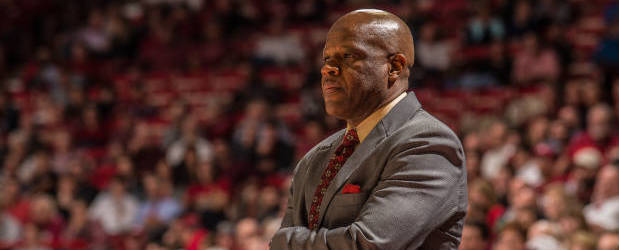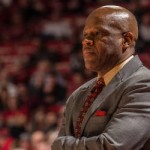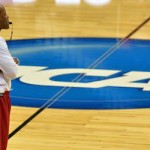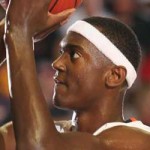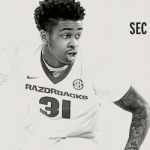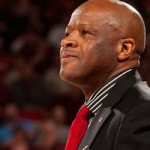 Not much was expected of Missouri’s basketball team heading into the 2008-09 season. The Tigers were coming off a 16-16 year marred by off-the-court dysfunction; the optimism accompanying Mike Anderson’s arrival in Columbia just two years before had left the building, his team’s 9-0 start that first fall a distant memory. The Tigers had stumbled to a 25-28 record afterward, so it was no surprise in Anderson’s third season his program was picked among Big 12 coaches to finish seventh in the Big 12.
Not much was expected of Missouri’s basketball team heading into the 2008-09 season. The Tigers were coming off a 16-16 year marred by off-the-court dysfunction; the optimism accompanying Mike Anderson’s arrival in Columbia just two years before had left the building, his team’s 9-0 start that first fall a distant memory. The Tigers had stumbled to a 25-28 record afterward, so it was no surprise in Anderson’s third season his program was picked among Big 12 coaches to finish seventh in the Big 12.
But, despite the naysayers, Anderson was seeing things in practice that gave him hope. He knew the pieces were falling into place for rapid improvement from the previous year: “We’re more athletic and a lot deeper,” he said in October, 2008. “There are more options now. We got a few more guys that can knock shots down. I think we’ve got some athletic guys that can make athletic plays in terms of blocking shots and rebounding. We’ve got more instinctive players.”
What followed was simply the most glorious season in Missouri’s basketball history, marked by 31 wins, a Big 12 tournament title and the Tigers’ first NCAA Tournament appearance in six years. In the Big Dance, Missouri knocked off Cornell, Marquette and a heavily-favored Memphis team led by John Calipari. By the end of that third season, Anderson had even exceeded the achievements of his mentor Nolan Richardson in his first years at Arkansas.
Now, of course, Anderson is back in Fayetteville. And only eight games into his third season as head coach there, Arkansas appears poised for an ahead-of-schedule breakthrough all its own. Like the Tigers of 2008-09, not much was expected of these Hogs – who were picked to finish eighth in the SEC – heading into the season. Also like those Tigers, Anderson’s third-year Razorbacks are showing enough improvement across the board on the offensive end to blow those prognostications out of the water. Can the Hogs keep it up and not only make the NCAA Tournament for the first time in six years, but shock the nation with a deep run there? That question will be better answered once conference games get rolling, but Arkansas has already played enough good competition to project how they will fare against SEC foes.
There are already signs that Arkansas in Year Three of the Mike Anderson Era could shatter expectations as Missouri did in its Year Three of the Mike Anderson Era. These Hogs resemble those Tigers in at least three ways:
1. Rims As Wide As the Lake of the Ozarks
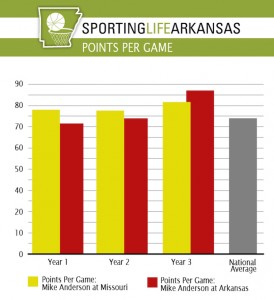 Call it “40 Minutes of Hell” or #Fastest40. Doesn’t matter. By and large, to the general fan, the term denotes defense – hot, sweaty Richard Simmons-y defense that in theory should leave all who have to get near it extremely uncomfortable. With Nolan Richardson and Mike Anderson’s trademark style, you know you are going to get a lot of effort, a lot of steals, not too many rebounds and breakaway dunks going both ways.
Call it “40 Minutes of Hell” or #Fastest40. Doesn’t matter. By and large, to the general fan, the term denotes defense – hot, sweaty Richard Simmons-y defense that in theory should leave all who have to get near it extremely uncomfortable. With Nolan Richardson and Mike Anderson’s trademark style, you know you are going to get a lot of effort, a lot of steals, not too many rebounds and breakaway dunks going both ways.
What really makes their system really click, though, is getting to the free throw line and accurate shooting. Free throw line stops and made buckets allow a defense time to set traps and make even more steals. Shooting three pointers at a high clip allows a team like Arkansas or Missouri to upset the Kentuckys or Kansases of the world. Richardson’s best teams of the early and mid 1990s also happened to his most efficient teams in terms of free throw percentage, field goal percentage and assists.
Arkansas’ offense this year is the program’s most efficient since the 1995 squad which made the national title game. Last year, Arkansas’ top two scorers – B.J. Young and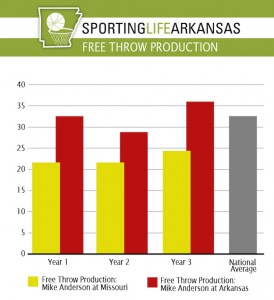 Marshawn Powell – each shot less than 67% from the free throw line. Young and Powell are now gone. This year, Arkansas’ top four scorers – Michael Qualls, Alandise Harris, Bobby Portis and Anthlon Bell – all shoot at least 73% at the line. And, as the chart at the right shows, they get there more often. Arkansas is also better balanced in terms of shot selection than it has been in recent years. In the last four games, Portis has looked like the most skilled Razorback post player since Corliss Williamson, and Harris and Qualls have shown refined mid-range games that have opened up shots for Arkansas’ sharpshooters.
Marshawn Powell – each shot less than 67% from the free throw line. Young and Powell are now gone. This year, Arkansas’ top four scorers – Michael Qualls, Alandise Harris, Bobby Portis and Anthlon Bell – all shoot at least 73% at the line. And, as the chart at the right shows, they get there more often. Arkansas is also better balanced in terms of shot selection than it has been in recent years. In the last four games, Portis has looked like the most skilled Razorback post player since Corliss Williamson, and Harris and Qualls have shown refined mid-range games that have opened up shots for Arkansas’ sharpshooters.
The 2008-09 Missouri Tigers didn’t have as many mid-range weapons as these Hogs have but they had an abundance of high-energy scrappers (e.g. DeMarre Carroll, Keith Ramsey, Justin Safford) who all shot above 54% from the field. Arkansas’ Jacorey Williams and Coty Clarke fill Ramsey-Safford type roles but both are shooting below 43%.
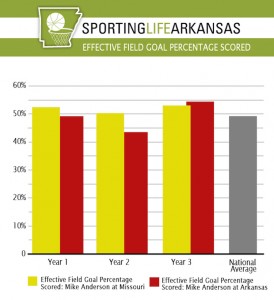 Missouri was a more explosive three-point shooting team with snipers like Matt Lawrence and Kim English, while DeMarre Carroll and Zaire Taylor also did a lot of damage from 21 feet out. The Tigers got an unexpected boost from Leo Lyons, who improved his three-point shooting nearly 30% from the previous season to 35.7%. Similary, Arkansas’ Ky Madden has broken out this season shooting 56% from the arc, thirty six percent better than last year. The Hogs’ offense has also been helped by a) the absence of B.J. Young, who bolted to the NBA after shooting 23% on threes last year and b) more selective and fewer shot attempts from Mardracus Wade, who shot 29% last year.
Missouri was a more explosive three-point shooting team with snipers like Matt Lawrence and Kim English, while DeMarre Carroll and Zaire Taylor also did a lot of damage from 21 feet out. The Tigers got an unexpected boost from Leo Lyons, who improved his three-point shooting nearly 30% from the previous season to 35.7%. Similary, Arkansas’ Ky Madden has broken out this season shooting 56% from the arc, thirty six percent better than last year. The Hogs’ offense has also been helped by a) the absence of B.J. Young, who bolted to the NBA after shooting 23% on threes last year and b) more selective and fewer shot attempts from Mardracus Wade, who shot 29% last year.
2. Onward and Upward with Forwards
Before NBA guard Tony Allen trademarked “Grit and Grind” as the motto of his Memphis Grizzlies, his former Grizzly teammate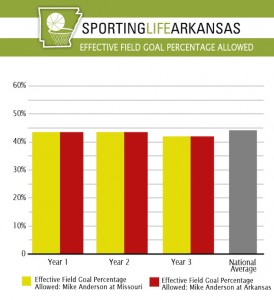 DeMarre Carroll personified the aggressive on-court M.O. for the 2008-09 Missouri Tigers. Carroll was a 6’8″ and 225-pound Hoover vac who sucked up more than seven rebounds a game and helped neutralize the size advantage of many of the Tiger opponents. He had transferred from Vanderbilt to play for his uncle, Mike Anderson, and had to sit out for a year. Like Carroll, Arkansas’ Alandise Harris had to sit out a redshirt year after transferring from Houston to be closer to family in his native Little Rock. The 6’6″, 237-pound Harris isn’t the force Carroll was on the boards but has a more refined offensive repertoire that will be just as important to Arkansas’ late-game chances as Carroll’s opportunistic points around the basket.
DeMarre Carroll personified the aggressive on-court M.O. for the 2008-09 Missouri Tigers. Carroll was a 6’8″ and 225-pound Hoover vac who sucked up more than seven rebounds a game and helped neutralize the size advantage of many of the Tiger opponents. He had transferred from Vanderbilt to play for his uncle, Mike Anderson, and had to sit out for a year. Like Carroll, Arkansas’ Alandise Harris had to sit out a redshirt year after transferring from Houston to be closer to family in his native Little Rock. The 6’6″, 237-pound Harris isn’t the force Carroll was on the boards but has a more refined offensive repertoire that will be just as important to Arkansas’ late-game chances as Carroll’s opportunistic points around the basket.
Before the 2008-09 season, Rockmnation’s Michael Atchison wrote Missouri “will go as far as the frontcourt duo of Leo Lyons and DeMarre Carroll can carry it.” He was right, as Carroll and Lyons, a highly skilled 6’9″, 240 pound power forward, ended up leading the team in points and rebounds while finishing in the top four in assists and steals. Similarly, Arkansas will only go as far as its top two forwards – Harris and 6’9″ power forward Bobby Portis – will carry it. They, along with the vastly-improved guard/forward Michael Qualls, pace the Hogs in scoring and rebounding. The health of those three players is pivotal to Arkansas’ chances of making any kind of postseason splash.
3. At Last, No Distractions
In Mike Anderson’s second year at Missouri, his Tigers stumbled through a seemingly endless series of off-the-court issues which stymied progress. The Tigers’ leading rebounder from his first year was kicked off the team in July, 2007, after being arrested for hitting a man in the face with the butt of a shotgun. That same month Carroll was shot in the ankle outside a downtown club while trying to break up a fight. Then, five players were involved in a late January 2008 fracas that ultimately resulted in the dismissal of leading scorer Stefhon Hannah and the arrest of the team’s other starting guard, Jason Horton. After the fight, Missouri staggered through the next four games, losing three, and never really recovered.
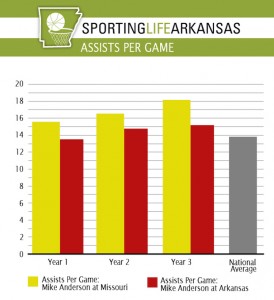 Most of the players involved in that incident were gone by the next fall and the Tigers welcomed seven new players who had all been recruited by Mike Anderson to fit his style. Only two players – Matt Lawrence and Leo Lyons – remained from the regime of Missouri’s previous head coach Quin Snyder and both players retooled their games to fit Anderson’s philosophy. In Year 3 the number of off-the-court distractions plummeted and payoff can be seen in the stats: improved shooting, improved defense and an “assist-to-misdemeanor ratio” as Atchison phrased it, that was no longer embarrassing.
Most of the players involved in that incident were gone by the next fall and the Tigers welcomed seven new players who had all been recruited by Mike Anderson to fit his style. Only two players – Matt Lawrence and Leo Lyons – remained from the regime of Missouri’s previous head coach Quin Snyder and both players retooled their games to fit Anderson’s philosophy. In Year 3 the number of off-the-court distractions plummeted and payoff can be seen in the stats: improved shooting, improved defense and an “assist-to-misdemeanor ratio” as Atchison phrased it, that was no longer embarrassing.
Arkansas hasn’t suffered through the same kind of off-the-court problems in recent seasons, but there has been a different kind of turmoil as the makeup of the roster changed from John Pelphrey-recruited players to primarily Mike Anderson-selected. The growing pains have included six players transferring out of the program in Mike Anderson’s first two seasons. A few of them, notably Rotnei Clarke, Julysses Nobles and Jeff Peterson, could have provided the outside shooting and point guard play the Hogs have so desperately needed the last couple years, especially on the road.
Only role players Kikko Haydar, Mardracus Wade and Ricky Scott remain from the Pelphrey era. Most of the rest of the main players – from rangy 6’5” Ky Madden to 6’10” Moses Kingsley – are long, athletic and quick, just like the ‘08-’09 Tigers. Most importantly, they play with a burning edge. This was especially evident during the second half of a Maui Invitational game against Gonzaga, when hot perimeter shooting had helped the Bulldogs secure a 17-point lead. The Razorbacks didn’t relent in their intensity, though, and battled back to cut the final margin to 10 points.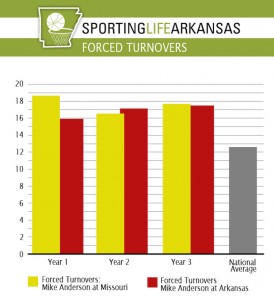
This kind of late-game effort is significant because it happened away from home. In recent years, the effort among the Razorbacks’ best players was erratic against the best opponents away from home. Marshawn Powell and B.J. Young accomplished many good things for UA basketball but leading memorable comebacks on the road wasn’t one of them.
***
Despite gaudy offensive stats, Arkansas won’t be taken seriously until SEC play begins and the Hogs actually win a couple games on the road. And Anderson hasn’t done his team any favors by packing a non-conference slate with so many cupcakes, many observers believe. But note Arkansas has already played six teams which are the caliber of above average to poor SEC teams. Against Gonzaga, California, Minnesota, SMU, Clemson and Louisiana-Lafayette, Arkansas has gone 4-2. Of course, none of those were true road games.
Heading into his third season, Mike Anderson well understood what was at stake. He remembers the breakthrough in his third season at Missouri and knows these Razorbacks have the talent and size to follow suit if they continue to pound the offensive boards, make their opponents pay at the free throw line and consistently hit 18-foot jumpers. There will still be slow stretches (Exhibit A: the second half against Clemson) and the lack of a true point guard will surely cost the team a few games. But, overall, an upward trend is unmistakable. The numbers show it as well as the players’ relentless hustle. “Each year, improvement has been made,” Anderson said in late October. “Now we need to take that next step.”
Mike Anderson at Missouri – The First Three Years
| 2006-07 | 2007-08 | 2008-09 | 2008-09 National Average | ||
| Points Per Game |
77.6 |
77.1 |
81.5 |
68.33 |
|
| Assists per Game |
15.5 |
16.4 |
18.1 |
13.05 |
|
| Effective FG Percentage |
52.70% |
50.70% |
52.90% |
49.23% |
|
| True Shooting % |
55.90% |
54% |
55.80% |
53.03% |
|
| Free Throw Production |
21.9 |
21.3 |
24.4 |
25.07 |
|
| Points Allowed per Game |
71.9 |
72.2 |
67.7 |
67.83 |
|
| Effective FG % Defense |
43.70% |
43.90% |
42.10% |
43.53% |
|
| Opponent 3-Pt FG % |
37.90% |
30.90% |
30.50% |
34.30% |
|
| Turnovers Forced per Game |
18.7 |
16.5 |
17.8 |
13.66 |
|
| Rebounds per Game |
32.2 |
32.51 |
33.9 |
31.43 |
|
| Possessions per 40 Minutes |
74.4 |
74 |
73.3 |
68.05 |
|
| Fouls per Game |
20.5 |
20.4 |
19.9 |
18.36 |
|
| Percent of Games Won |
60% |
50% |
81.60% |
Mike Anderson at Arkansas – The First Three Years
| 2011-12 | 2012-13 | 2013-14 | 2013-14 National Average | ||
| Points Per Game |
71.8 |
73.7 |
86.8 |
73.81 |
|
| Assists per Game |
13.5 |
14.8 |
15.2 |
13.09 |
|
| Effective FG Percentage |
49% |
43.20% |
54.60% |
49.32% |
|
| True Shooting % |
53.10% |
52.10% |
59.80% |
53.83% |
|
| Free Throw Production |
25.7 |
23.6 |
36.3 |
28.79 |
|
| Points Allowed per Game |
69.7 |
68.8 |
73.5 |
71.35 |
|
| Effective FG % Defense |
43.40% |
43.20% |
42.10% |
44.19% |
|
| Opponent 3-Pt FG % |
32.50% |
36% |
36.60% |
34.03% |
|
| Turnovers Forced per Game |
15.8 |
17.2 |
17.4 |
12.54 |
|
| Rebounds per Game |
30.3 |
31.8 |
32.8 |
32.98 |
|
| Possessions per 40 Minutes |
71.7 |
71.7 |
75.1 |
70.21 |
|
| Fouls per Game |
19.2 |
20.3 |
20.3 |
20.05 |
|
| Percent of Games Won |
56.30% |
59.40% |
75% |
***
Oh yes, Evin Demirel did … blog about the most jaw-droppingly dominant athlete in Arkansas college sports. And Tweet about some sportsy stuff, too.


